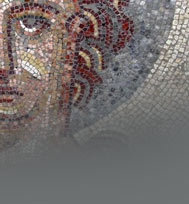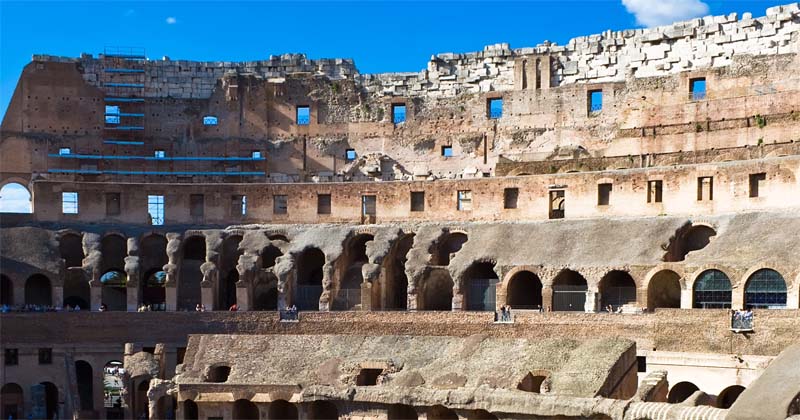


Arches were an architectural invention used
throughout the Roman Empire. Furthermore, arches were
used both for architectural design and support in many
of Ancient Rome's buildings and monuments. The most
notable structure in Rome that used arches was the Roman
aqueduct systems, which were used to bring fresh water
to cities throughout the empire. Roman arches were also
used to construct the famous Roman Colosseum where many
gladiators and Roman events were held to entertain
citizens.
Arches were also used in Roman buildings because of
their strength and support capabilities. They work
because they are curved, which allows structures to pass
weight from above, down to the ground through piers that
support the arch. Additional forms of arches are vaults
and a barrel vaults. A vault is a long arch that makes
massive structures possible. This allowed Romans to
build massive buildings compared to traditional masonry
techniques that were limited and were not able to
withstand massive amounts of weight. Barrel vaults were
used in Ancient Roman bathhouses because of their
strength and structure properties. Unlike traditional
masonry with wood roofing, these barrel arches were
resistant to decay and humidity and weather. This was
ideal for bathhouses of that time era.
Aside from incorporating arches for its structural
properties, arches were also used because of their
beauty and architectural advantages. Arches were also
incorporated with components of Greek architectural
traits because of their beatifying properties. These
traits consisted of: columns, capitals, architraves, and
pediments. Many of the architectural techniques can be
found throughout Roman and Greek buildings. It was the
Ancient Romans who really took advantage of these
architectural designs to adorn their monuments. Ancient
Rome was an empire that adopted many of their building
techniques from people they conquered or architectural
trails they liked.
Roman builders and architects became so successful at
building structures with arches that before long, the
empire was erecting buildings that would adorn the
landscape. A famous example of this is the Colosseum. It
should be noted that the Colosseum would probably be
intact if it was not for robbers. The reason it looks so
aged is that it was robbed for stone in the middle ages
that were used for other purposes.
Ancient Romans used arches in many of their structures,
but they did not invent them. They originally came from
the Etruscans who had a huge influence on Roman
architecture as well as many other aspects of Roman
rule. Etruscans were an early ancient civilization of
ancient Italy around the area of Tuscany.
Famous Roman Buildings with
Arches
Colosseum
The Colsseum is known as the Flavian Amphitheatre and
was started by Emperor Vespasian and finished by his son
Titus. This grand amphitheater was built with 80 arched
entrances that allowed spectators to participate in
Roman events and gladiator fights. Today this massive
structure still stands as a tribute to Ancient Rome’s
architectural achievement and building capabilities.
Triumphal Arches Used To
Celebrate Victories of Wars
The Arch of Septimius Severus
Built in 203 AD, this arch is approximately 70 feet
high. This arch is located on Capitoline Hill and was
built in honor of the victory over Parthians, which is
modern day Iraq and Iran. It was also built to
commemorate Emperor Septimius Severus and his two sons;
Caracalla and Geta. After Emperor Septimius died, the
two brothers became joint rulers. Caracalla had his
brother Geta killed and removed from the famous Arch due
to jealousy.
The Arch of Titus (Arco di
Tito)
Built in 81 AD, this arch is approximately 50 feet high.
This arch is located on at the Via Sacra on the eastern
side of the forum and was built in honor of the victory
of the Judea by Vespasian and Titus. This event was the
beginning of the Jewish displacement throughout Europe.
This Arch was erected by the Emperor Domitian after his
older brother Titus death.
Arch of Tiberius (Arcus
Tiberi)
Built in 16 AD, not much is known about this arch. This
arch was built to celebrate the victory of Germanics. It
was dedicated to the emperor Tiberius because in the
Imperial period only the emperor could celebrate a
Triumph.
Arch of Augustus
Built in 29 BC, this arch marks the victory of Actium in
31 BC against Anthony and Cleopatra. This arch was to
Augustus. Little remains of this arch; however,
depictions are seen from coins of that area. It should
be noted that this arch is the first arch in Ancient
Rome and lead the way for others to be built throughout
the empire.
Arch of Constantine (Arco di
Costantino)
Built in 315 AD, this arch is approximately 85 feet tall
and is located between the Colosseum and the Palatine
Hill. This arch was built to commemorate the victory of
Maxentius by Constantine I. This arch was built by
reusing parts from earlier buildings.
Roman Aqueducts
Aqueducts were used throughout Ancient Rome because the
population of Roman cities grew tremendously and water
was in demand. The first roman aqueduct was built in 312
BC. These aqueducts were built by high arches and
pillars on a gradual grade to bring water into the city.
These aqueducts were essential to making Roman cities
thrive due the demands of water. Three hundred million
gallons of water were brought into Rome by 14 different
aqueducts each day. Water in Ancient Rome was used for
bathhouses and sewers. Water use of Ancient Rome rivaled
that of today’s big cities. It should also be noted that
aside from the ancient Egyptians, they were one of the
first ancient civilizations to harness the power water
and move it freely throughout the empire.